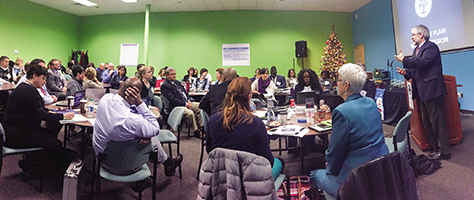
|
Emily Douglas-McNab
|
Ten years ago, rural schools and some urban districts were seeing shortages of teacher talent in specialty areas. Today, that shortfall has become much more pronounced, confronting teacher preparation programs and suburban school districts even in highly affluent areas. All are struggling to place talented people in the classroom — and not just in the sciences, advanced math and special education.
When Gallup surveyed 1,900 superintendents this past summer about the greatest challenges they face leading their local schools, the issue rising to the top was recruiting and retaining teachers. Many of them could remember the days, not so long ago, when most posted positions drew multiple applicants — which made everyone seem replaceable. Now, the applicants hold the upper hand.
This dynamic economic and employment environment is requiring local school communities to develop a fresh mindset in how they attract, grow and retain teaching staff. This new thinking is known as a human capital management system.
A Strategic Priority
Education is a people business. The shift from personnel to human resources to human capital management involves more than just a change in the lexicon. While some deride the term “human capital,” believing it means looking at people inhumanely as numbers on a balance sheet, the term is meant to encompass just the opposite.
Human capital management, or HCM, is an approach to people management that treats it as a high-level strategic priority. Through this very human perspective on the profession, HCM seeks to systematically analyze, measure and evaluate how people, policies and practices help us reach our goals for students.
What draws many people into the field of education is the belief that when we educate children, we are providing for a better future. In this sense, we are all human capital advocates — whether or not we realize the meaning of the term.
While many school districts have begun the journey to transform their organizations through HCM, the structures and processes behind that work look very different. When we work with school districts and state education systems, we often are asked three big questions from those in charge with respect to human capital management:
» What is the difference between a human resource department and a human capital management system?
» Who should be making these decisions — school-based staff or central-office administrators?
» How should we support those in human capital management leadership?
Human Investment
Historically, personnel departments were transactional bodies that kept records and posted jobs. While needed, these tasks didn’t necessarily generate strategic value for organizations. Even after changing names a few decades ago, many HR departments continued to serve as standalone silos and HR directors were rarely invited to cabinet meetings.
Strategically investing in people creates a more satisfied, engaged and loyal workforce, which ultimately leads to better outcomes for students. Under this new model, the chief of human resources is seen as a destination position, not a resting place on the way to another post. These leaders have a seat at the executive table alongside the chief operations and financial officers, and they are responsible for carrying out the human capital management strategy.
We see some school districts around the country empowering HR leaders and weaving them into the strategic work of the district. Among them is Klein Independent School District in Texas. With more than 53,000 students, Klein is driven by the vision that every student “enters with a promise and exits with a purpose.” The district website showcases its profile of a learner and profile of a leader, which contain the competencies they believe are needed to be successful in the 21st century. Additionally, their strategic plan emphasizes the importance of cultivating talent.
Klein’s HR department then is charged with working with leadership to create aligned processes. HR engages building leaders to craft interview questions to ensure all new teachers are able to cultivate the competencies identified in their profile of a learner. Martha Werner, executive director of human resource services, says she and her colleagues “take the vision of the district and make it come to life by hiring people who will work and continue to grow the vision. We continuously work to align all HR processes with our guiding documents.” The strategic alignment ensures students and staff will meet school district goals.

|
Sequita Freeman served as the chief of human resources for the Troup County, Ga., schools, where she trained others in human capital practices.
|
Decision-Making Acts
We often are asked by district leaders whether it’s better to have centralized or decentralized processes. While it is easy to distinguish the characteristics of each, neither is necessarily better than the other. It depends on the life-cycle stage, leadership and strategy of the organization.
In centralized processes, the “power,” or decision-making authority, lies with a group or individual at the top. Other staff carry out those decisions. This approach can improve consistency and help organizations control costs, quality, messaging and overall operations. Difficulties arise when top-level leaders lack the expertise or contextual knowledge for key decisions. This approach also can create bottlenecks when employees have to wait for a decision or direction from the top. Payroll is an example of a process that is often centralized. Districts typically have a specific process that details how time is tracked, compensation rates are assigned and pay is processed.
Decentralized processes take the opposite approach. Decision-making authority is spread to managers at various levels. Decentralized decision making takes local context into account and moves more quickly. Staff may feel more engaged to make choices about their work.
Yet potential downsides exist for decentralized processes and decision making. Decisions may be inconsistent with each other and misaligned with organizational goals. Barriers arise even when it comes to basic communications as there may be confusion as to who owns relationships.
Further, decentralized processes mean that we rely heavily on the expertise and passion of the people making decisions. While some get a quick tutorial on hiring or employment law, many school and district leaders are not taught specifically about human capital management or human resources practices. Thus, while decentralized decision making may be empowering for some, others may feel burdened or unprepared — which isn’t their fault.
Site-Based Input
In our experience, many school districts have decentralized their teacher selection process. School-based leaders individually determine the selection criteria, interview the candidates and extend job offers. These types of systems can be found in districts across West Virginia.
With changes adopted in July 2013, the state put in place procedures for designated hiring and transfer of school personnel. This means that while human resources may post positions, principals and/or newly established faculty senates establish selection criteria and conduct whatever process they devise. The human resources department does the final vetting and background checks. Teacher candidates who make it through the entire process are recommended to the superintendent for hiring.
Justin Schooley, assistant superintendent in Berkeley County, W.Va., says many of the state’s districts used centralized hiring for teachers prior to 2013. Over the last five years, his district has moved to a new selection system that empowers building teams. “Acceptance of the new process was hard initially, but this approach allows for more input from staff and provides greater opportunities for examination-of-fit concepts,” Schooley says.
With 19,500 students, Berkeley County, sitting 75 miles northwest of Washington, D.C., in the state’s eastern panhandle, has struggled to find qualified teacher applicants. The district posted nearly 400 job openings and hired approximately 160 new administrators and teachers for the 2018-19 school year. “While we still have 89 classrooms staffed by permanent substitutes,” he indicated at the end of September, “decentralizing our selection process has empowered teachers, and they have become more engaged in recruitment.”
The 5,000-student Perrysburg Exempted Village School District in Ohio has developed a hybrid approach to compensation that incorporates both centralized and decentralized processes. Perrysburg is a suburban district in northwestern Ohio with approximately 600 staff members. Since 2014, the district has used a compensation system that gives teachers opportunities to earn additional pay based on their leadership, learning and performance. Leaders collect the data, HR manages the system, and the treasurer’s office handles payroll.

|
Paolo DeMaria (right), Ohio’s state superintendent of public instruction, addressing executive leadership teams from local districts at a conference focusing on human capital strategies.
|
Aura Norris, Perrysburg’s executive director of human resources and operations, has designed the human resource function to maximize the time and resources of building leaders on instructional affairs. “The demands placed on building leaders today are ever-expanding,” Norris says. “While we are a growing suburban district, we know that our department needs to ensure our work is done effectively and efficiently so everyone in the district can spend their time supporting students. This also means that we are being good stewards of public funds.”
Small, rural districts without a designated HR function or leader have found creative ways to centralize efforts to address human resource challenges. To deal with teacher recruitment pressures, rural districts in Colorado worked jointly with the Colorado Rural Education Collaborative, a partnership formed by Colorado State University-Pueblo and the South Central Board of Cooperative Educational Services.
The collaborative runs what it calls “recruitment immersion events” for two small districts in southern Colorado with staffing needs that were not drawing sufficient candidate interest. The events invited current teachers, students completing teacher preparation programs and individuals with bachelor’s degrees interested in becoming credentialed teachers to get to know the two communities, leading to the hiring of qualified teachers who otherwise would have overlooked these out-of-the-way places.
Leadership Backing
Human capital leaders can be found across the organization, in departments beyond HR. Anyone who hires, evaluates, manages or leads people is a human capital leader as they are both responsible and accountable for the growth of others.
What does this expanded leadership model look like in school districts? Fort Wayne Community Schools, the largest in Indiana with about 29,000 students, is building a comprehensive human capital management system. Under the leadership of Wendy Robinson, superintendent of the urban district for 15 years, Fort Wayne is using federal grants and general funds to devise comprehensive strategies to support educator effectiveness and raise student achievement through the PEER, Performance+Equity=Excellent Results program. PEER engages educators at various levels to serve as human capital leaders, not just those in the HR department.
Leaders from HR, professional learning and technology departments have participated in a national certification program for human capital, run by the American Association of School Personnel Administrators and Battelle for Kids. All building leaders attend an administrator academy, which focuses on human capital issues.
We know great teachers can change the course of a child’s life. Great leaders inspire and empower educators to be their best. And experienced and caring support staff play a critical role in student success. If educators are going to prepare all students to succeed in school, career and life, we need to be more purposeful in the design and implementation of transformational human capital management. Our ability to meet it will determine our children’s future.
EMILY DOUGLAS-McNAB is senior director of improvement and impact at Battelle for Kids in Columbus, Ohio. Twitter:
@EmilyDouglasHC.
KATHERINE HEYNOSKI is director of improvement and impact at Battelle for Kids, where
TONY BAGSHAW is chief improvement officer.